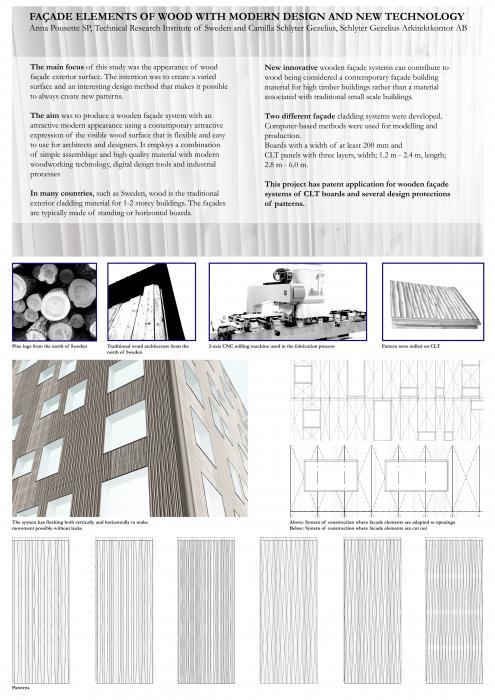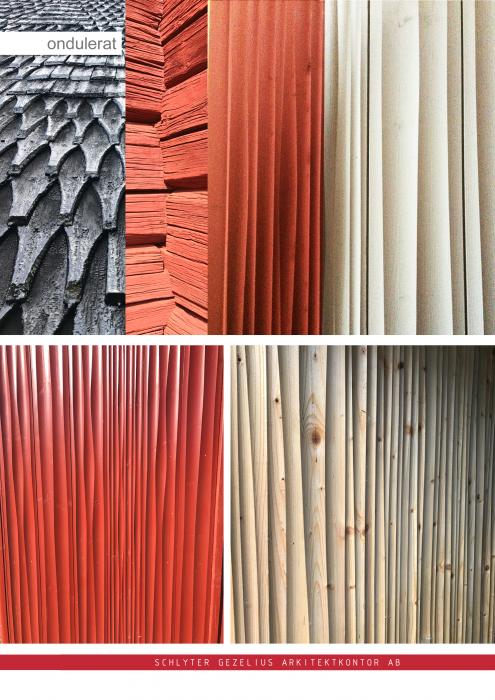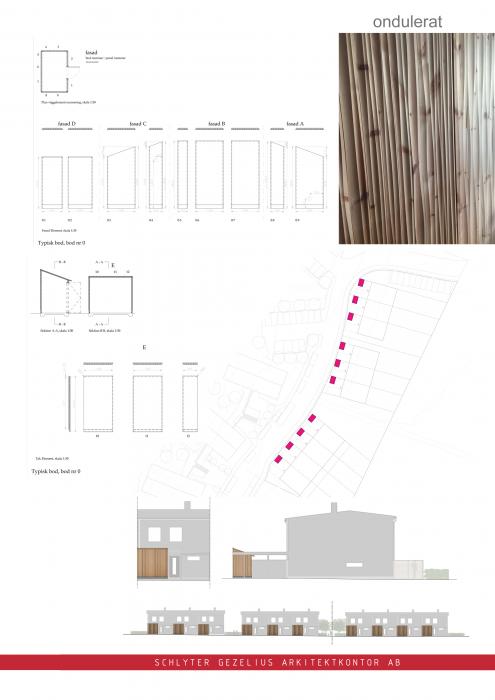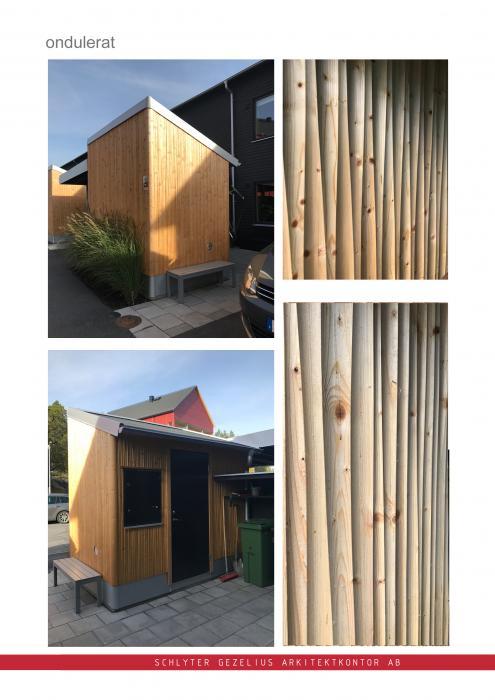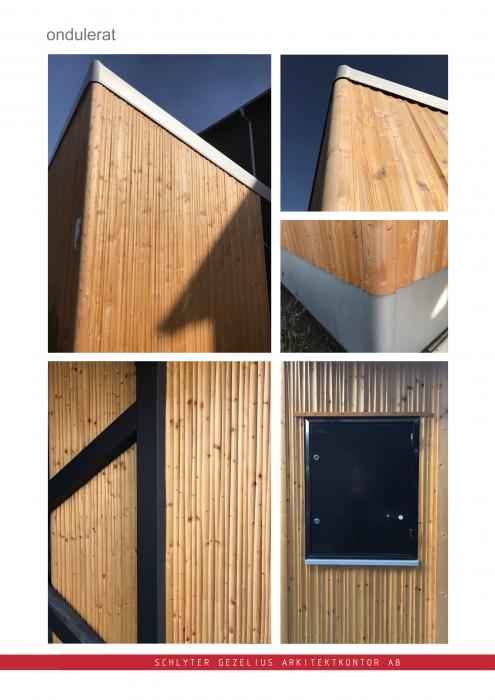I. SUMMARY INFORMATION
Project
268942
Status
Submitted
Award category
Techniques, materials and processes for construction and design
You want to submit
NEW EUROPEAN BAUHAUS AWARDS : existing completed examples
Project title
Innovative Wood façades
Full project title
Innovative Wood Facades
Description
The project innovative Wood façade concerns product development and material research with focus on the potential of industrial wood construction. Through innovation and product development of wood-based façade systems, traditional wood crafts are combined with modern industrial manufacturing methods, where design and architecture, quality, traceability and life cycle analysis are in focus. Partners are RISE and the Nordic wood industry.
Where was your project implemented in the EU?
Sweden
Stockholm
Ragvaldsbo Gårdsväg 15 -33
Stockholm
193 37
When was your project implemented?
Has your project benefited from EU programmes or funds?
No
Which programme(s) or fund(s)? Provide the name of the programme(s)/fund(s), the strand/action line as relevant and the year.
II. DESCRIPTION OF THE PROJECT
Please provide a summary of your project
The project innovative Wood façade concerns product development and material research with focus on the potential of industrial wood construction. Through innovation and product development of wood-based façade systems, traditional wood crafts are combined with modern industrial manufacturing, where design and architecture, quality, traceability, and life cycle analysis are in focus. Partners are RISE, Karin Sandberg, and the Nordic wood industry. The project utilizes modern technology in the wood industry to produce a façade system with a modern expression. The idea is to combine new research and use the potential of wood crafts tradition, digital design tools and already established high-tech industrial processes in the wood construction with a point of departure to help evolve the future sustainable building industry!
Please give information about the key objectives of your project in terms of sustainability and how these have been met
From an environmental point of view, wood is a CO2 low-emission material. Wood requires little total energy to process, and the material is derived from local natural resources that are renewable. In Sweden the wood industry uses the residue of wood to rum the plants, they do not need to use other sourced energy. Increased use of wood for building structures can therefore contribute to reducing carbon dioxide emissions. Since it is a lightweight material wood provides relatively low emissions from transport. We have endeavored to meet these concerns by designing the façade system of a renewable material, wood. The raw material is sawn wood directly from the unprocessed wood. The facade system has a unique design that enables architects to design the facade in many ways. Meetings, corners, joints, and openings are designed and designable. CLT (cross laminated timber) boards and boards are manufactured in untreated wood, thus creating a minimum of maintenance and wears in a beautiful way.
We see a need for innovative thinking in the construction industry to meet today's complex environmental goals. Therefore, the facade system project is important, we consider it a possibility to influence forestry and the wood building industry by stimulating the development of processed forest products with a focus on building in wood, sustainability, heritage, and product development in the construction industry with the aim of creating good architecture. Our ambition is to surpass environmental goals set for building materials. By contributing and develop the future of the building industry with the point of departure, a landscape in balance! We do this by focus on renewable materials, architectural design and design of buildings where high demands are placed on design, technology, and quality. We see a clear connection between traceability, quality, and forestry. We want to contribute to an increased demand for a high quality of raw materials from the European forestry industry
Please give information about the key objectives of your project in terms of aesthetics and quality of experience beyond functionality and how these have been met
The aim of this project is to produce a wooden façade system with an attractive modern appearance usable in both small scale, large scale and renovation projects and good constructive design with the help of digital software and modern woodworking technology. We have investigated how different milling techniques can be used for facade products and studied possible patterns and limitations. I have as an example studied the old Nordic technique “skave” which was an old technique using an ax to make beautiful and durable surfaces. Can we use the aesthetics from this method and combine its technical/functional aspects today? Yes!
By utilizing modern technology available in the wood industry, we can produce building products with a modern expression in a way that uses little energy and is cost efficient. In this project this has been done by combining new research on wood and using the potential of wood craftmanship tradition, digital design tools and already established high-tech industrial processes within the wood construction industry.
We have built and tested prototypes in scale 1: 1, then evaluated them functionally and aesthetically and further developed the system together with our partners. In large scale we have tested one of these systems in Sigtuna (a small city by the lake Mälaren), consisting of 10 shelters for Folkhem AB constructed by Stora Enso and Sjölinders Carpentry Shop.
Please give information about the key objectives of your project in terms of inclusion and how these have been met
Wood is a renewable material, and, in all cultures, has been used for crafts and construction since the dawn of mankind.
The project has been conducted as an interdisciplinary exchange of knowledge and by combining traditional knowledge and today’s industrial knowledge. We have within the project endeavored to create an interesting collaboration between groups that do not often meet and scare experiences and knowledge. Such as craftsman/woman, industry, and science/research. Within the project as a starting point, we have listened to different aspects, in order to make every voice heard. We have in the process reached out to larger groups to assess the aesthetic and functional aspects of the project by inviting the public to interact.
By designing the system so that it makes it possible for the architect to, within the systems boarders, be able to adapt the design towards different scenarios and thus make it easier to interact with different contexts in order to create a unique architecture for the local context.
Please give information on the results/impacts achieved by your project in relation to the category you apply for
The project concerns product development and material research. Through innovation and product development of building systems in wood-based materials, traditional wood crafts are combined with modern industrial manufacturing, where design and architecture, quality, traceability, and life cycle analysis are the focus. The impact is primarily that with modern technic the facade system and all its components make it possible coastwise and technically to produce in an industrial scale with design and quality intact. For instance in this project using the Computer Numerical Control (CNC)-machine. CNC is a computer system for controlling workshop machines that are programmed numerically. The control system allows complicated parts to be manufactured in a uniform and automatic way by prepared digital input with x,y,z information, in this case a 3D file. The information on the surface can thus be changed by the architect within the borders of the system in order to create a design fitting the context.
By using 3D software there is an interesting opportunity to design a wood façade system in a new way. Unique solutions can be created with digital technology in design and machinery. The work is based on digital models for production and a digital and flexible workflow from design to production allowing for customized fabrication, considering specific requirements of individual buildings, e.g., size.
List of patents as a result for further development:
1.Application Swedish Patent 1 has been submitted 2014-09-05 received No. 1451040-8 name: "Facade elements". Granted.
2. Application Swedish Patent 2 was submitted 2014-10-13 received No. 1451222-2 name: "Facade elements". Granted.
Patent pending in the EU and USA.
Please explain the way citizens benefiting from or affected by the project and civil society have been involved in the project and what has been the impact of this involvement on the project
In a larger global scale wood and other renewable building materials will be increasingly important, since the ecological footprint is very low compared to other building materials. Quality in the wood construction industry includes to a large degree material issues, for example: how our forests are used, how the use of construction parts made of non-renewable materials affects our environment and how energy consumption in manufacturing, transport and construction looks.
If we increase the quality of wood, biodiversity in our foresting can increase the quality of European forests. By connecting knowledge about traditional wood working a with today's high-tech knowledge we can develop a more biodiverse forest. This will create a large impact on not only citizens but also for plants and animals in the forest.
Traditional knowledge of wooden house construction is a starting point. With this project we hope to aid and help develop knowledge about the local / regional landscape, its history and future as well as help stimulate local / regional industry.
An upgrading of wooden details and craftsmanship is a great way to develop, enrich and extend the architecture of the future, creating a beautiful and sustainable modern architecture. The façade system makes it easier for architects to create more aesthetic beautiful projects with the benefit that people appreciate wood as a building material recent research has shown. Recent research has also shown the people being exposed to wood in buildings benefit healthwise, researchers have shown the for example recovery from illness goes quicker if surrounded with wood material!
Wood is easy to shape and process if we keep within the limits and possibilities of the material. Every European country have their own agenda and heritage to develop together with (hopefully) an international knowledge of wood building.
How can forgotten crafts become a resource for a sustainable future?
Please highlight the innovative character of the project
We have focused on the development of high-tech craftsman/woman where the design process is the creative engine. We think this way of working can develop both architecture and manufacturing! By developing and creating a better quality on a buildings' details and materials, as well as using hardwood and softwood, we can create more beautiful buildings and details by industrial manufacturing. By showing the possibilities with the link between advanced design using digital tools to be used in the product development of wood construction details. There is the opportunity to develop quality products for the wood building industry! We see the details as crucial. They are the alphabet of the architecture. Today, the unique details are within reach. Wood is a plastic and malleable material, and a carpentry is a meeting place between software and materials. You can set a saw blade and a lathe after a data file. This combined by an increase interest in cultural heritage – seen as a link between countries and cultures has a great development potential.
Please explain how the project led to results or learnings which could be transferred to other interested parties
The background to our research and product development is that we see a need for innovative thinking in the construction industry to meet today's complex environmental goals with the future's demands for quality and traceability. The interest in bio-based materials is increasing among environmentally conscious architects and builders. Our starting point is a deep willingness to act for increased construction in renewable materials associated with good architecture. This can lead to a higher proportion of wood products being used in the European construction industry, products that come from sustainable forest harvesting where biodiversity is ensured. By working in close cooperation with manufacturers, builders, engineers, we are close to the manufacturing and construction process and learn "hands on" how to make architecture! In this project we have worked closely with the industry checking every aspect through the duration of the project, this is a great way of developing wood building and architecture now and in the future. By showing and discussing the work by prototypes and real-life projects we have also been able to collect reactions from the general public.
We need to collaborate on all levels to understand both construction technology and the design process and how they in turn affects the physical landscape. This is a great possibility at all levels.
All surveys show that the wood building industry will continue to grow because its benefits on health and livability benefits. Through care about both foresting and its associations on details, this can lead to an increased quality of raw material in the long term, a development of how our forests is used, an increased interest in traceability, life cycle analyzes and, in the best case, an increased element of wood in our surroundings.
There is a growing interest for this, design and health friendly materials within the building industry!
Is an evaluation report or any relevant independent evaluation source available?
No
III. UPLOAD PICTURES
IV. VALIDATION
By ticking this box, you declare that all the information provided in this form is factually correct, that the proposed project has not been proposed for the Awards more than once under the same category and that it has not been subject to any type of investigation, which could lead to a financial correction because of irregularities or fraud.
Yes
